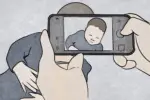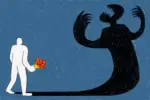Over the last few months, TikTok has gotten quite strange. Scrolling through the app, one can expect an abundance of entertainment — a makeup tutorial or two, a staged prank or a trending dance routine. Then suddenly, you may come across a clip of serial killer Ted Bundy or coverage of a grisly murder. True crime content on TikTok has been on the rise in recent months, with creators gaining millions of views and followers by covering infamous cases. H.P. Lovecraft once stated, “The oldest and strongest emotion of mankind is fear, and the oldest and strongest kind of fear is fear of the unknown”; TikTok’s true crime touches on that instinctual human emotion while simultaneously exploring and investigating all things morbid. However, when millions of people can become detectives from their couch, things start to go awry.
Humanity’s fascination with all things disturbing is logically understandable and normal — to an extent. It allows people to explore dark realities from the comfort of their own homes, and, according to psychologist Emma Kenny, “trigger[s] chemical reactions in our bodies, while also affirming our moral views of right and wrong.” Gaining insight into the darker aspects of society helps people prepare for the worst and reaffirms a sense of security.
By viewing true crimes on TikTok, viewers can feel reassured that they are not in the situation depicted. What’s most important is that “detective” feeling that one has while watching these true crime videos. People love to solve problems; it’s in our nature. If one sees a fellow person in a situation they can relate to, then there is a desire for justice — because when law enforcement is not up to the task, people feel the need to take it into their own hands.
Unfortunately, TikTok sleuths have the ability to take theories too far — turning innocent people into spectacles for entertainment. Sabrina Prater, a transgender contractor from Flint, Michigan, in the process of renovating a house for her family, just wanted to express herself. She downloaded TikTok to practice her dance moves and celebrate her gender identity but was met with a brutal reaction. With a decrepit-style background and dim lighting, Prater strutted for the camera in skinny jeans, a crop-top and heels to Shania Twain’s “Any Man of Mine.” The video quickly gained traction, amassing millions of views and an abundance of both parodies and criticism.
A trend emerged — people dancing with a green-screened Prater in the background — but then the situation took a sinister turn. Conspiracy theorists began to make videos analyzing Prater’s content, claiming a computer screen in the background of a video was meant to monitor her hostages, and her clothes were stolen from her victims. Content creator @dandydemon summarized the controversy in a TikTok, stating, “The main conspiracy theory is that this person who runs this account is a serial killer and they are hiding little clues and evidence in the background of their videos.”
Some theorized that the stains visible on the floor in the videos were blood, or that the choppy sound in the background was actually the victims begging for help. Prater, in an act of blatant transphobia, was pinned by some as resembling the serial killer Buffalo Bill from “Silence of the Lambs.”
In the 1991 horror film, the character Buffalo Bill uses the bodies and clothing of his female victims to make “women suits” after being denied gender-affirming surgery. The twisted narrative of transgender people as psychologically unhinged has long existed in society as a harmful stereotype and has sadly carried on into Prater’s case. Some attempted to connect her videos to Flint missing persons cases, reporting her to the local sheriff’s office. Yet, the innocent nature of Prater’s videos was soon made clear.
In a heartbreaking, now-deleted video, Prater cried as she adamantly begged TikTok to stop harassing her, stating, “Here I am, I got violated again for being me. I didn’t do nothing wrong!” Prater also uploaded a series of videos to her account called “Ten Questions w/ Sabrina,” where she is interviewed by two fellow TikTok creators.
She clears up the strange conspiracies, addresses how her house is actually mid-construction and not a torture dungeon and speaks on the falsities of the kidnapping accusations. While some of the main conspiracy theorists have issued apologies to Prater, many of the damaging videos and comments still remain online. One begins to question, if Prater was younger, cisgender and lived in a lavish mansion, would she still receive this treatment?
While TikTok sleuths have the ability to hurt, they also have the ability to help. For instance, in a now-deleted 2020 TikTok video, a group of teens were filmed as they discovered a suitcase near a Seattle pier. At first, the teens are seen giggling, believing the suitcase might be full of money, but upon opening found something wrapped in a plastic bag with a strange smell.
Still questioning if it was perhaps filled with something menial like rotten food, the responsible teens called the police anyway, and the contents were found to be human remains. Their discovery helped solve the case of a missing young couple, who were murdered after a dispute with their landlord. These teenage sleuths helped find justice for two people who met a heartbreaking demise and gave closure to their families.
TikTok has helped solve decades-old cases as well, such as the 2001 disappearance of 17-year-old Alissa Turney. The social media platform has a unique ability to spread information to a large audience. Through this, Turney’s younger sister Sarah Turney was given the chance to bring awareness to the case. Over 20 years later, Turney’s stepdad, Michael Turney, has been charged with second-degree murder in a “no-body homicide” investigation. Sarah provided childhood videos on TikTok of her sister, as well as phone call recordings that depict her complicated relationship with their stepdad.
Another audio recording shared by Sarah found Michael saying he would provide answers “at the deathbed.” After Michael’s conviction, Sarah was applauded by the local county attorney for her dedication to her sister’s case. Perhaps, without her use of TikTok to bring awareness to the very suspicious evidence, Alissa’s case would have remained unsolved.
As viewers across the globe watch true crime TikToks, their curiosity piqued, there is a sense of underlying fear, an empathy that comes with being human. For others, the content functions as a Sherlock Holmes type of entertainment, putting viewers into the role of detectives. As technology and social media infiltrate every aspect of daily life, one begins to wonder — will TikTok have a lasting impact on the future of criminal cases?

















